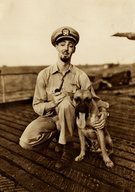
|

|
|
|
|
Earl was born in Hope, Arkansas, as one of two children to Earl and Clemmie Pearl Robinson Archer. The family lived briefly in South Texas, but in 1929 returned to Arkansas. His father purchased several trucks and laid gravel in building a highway from Hope to the Louisiana line in the early 1930s. Meanwhile, the family also raised cotton on its farm where Earl worked as a youngster, plowing with a mule and using other implements. "My daddy taught me how to do everything," he says. "I could take a cultivator and lay back a cotton crop as good as anybody when I was twelve years old. He taught me how to work." Later the Archers moved into Hope where his father purchased an automobile garage and service station, paying for it, Earl recalls, with "a can of gold he had buried." Founding Archer Motor Company, Earl's father sold Studebakers and Packards and ran a service station where Earl worked. On Sundays the family attended a Baptist church. He graduated from Hope High School in 1939 and then entered the University of Arkansas, where he majored in business administration. In the summer of 1941 he began working "the graveyard shift" at an artillery proving ground in Hope, where he earned around "three hundred and some dollars a month." After the Japanese attacked Pearl Harbor he enlisted in the U.S. Navy. Earl, who made model airplanes as a youngster and suspended them from the ceiling in his room, entered flight training, first in New Orleans, then in Pensacola where he earned his wings in February of 1943. In Miami at Opa-locka, a naval air station, and in nearby Fort Lauderdale he trained in torpedo bombers. In June of 1943 was sent to Chicago to qualify in carrier landings aboard the USS Wolverine (IX-64). Returning to Florida, he trained as a landing signal officer in Jacksonville. In September of 1943 he was sent to the west coast where he joined a squadron and trained in torpedo bombers in Arlington, Washington. Sent to the Pacific, Earl was based aboard the jeep carrier, USS Kalinin Bay (CVE-68), as a TBM torpedo bomber pilot. He began flying missions, most lasting four to five hours, and often two a day. His first action was in the invasion of Saipan on June 15, 1944 when he crisscrossed the island at "three or four thousand feet" taking photographs. He also flew close-air support for ground troops. Earl often took on enemy fire in subsequent missions as an artillery spotter. Once, he made a carrier landing without wheels. "They hit the plane, but they didn't shoot me down," he states. When another pilot crash-landed at the end of a runway the Marines had captured (Japanese held the other end) Earl swooped down and picked up the pilot. Earl later participated in the invasion of Guam, then saw action in the Palau Islands. Because of breathing gas fumes for "six or eight hours a day, or nine or ten some days," he had difficulty eating. In the invasion of the Philippines, Earl flew through squalls and bombed a Japanese cruiser, shot the bridge off another cruiser with a rocket, and made torpedo runs on battleships. Once, with no ammunition or bombs remaining, he swooped down on a Japanese battleship and fired his .38-caliber pistol at the bridge. "I always brag and the fellows always kid me--the only fellow in the U.S. Navy got six hits on a Japanese battleship with a .38." The Kalinin Bay "was shot up so bad we couldn't land back aboard it," he says. Instead, he landed on the beach at Leyte. He also hurt his back that day, a combat injury that still bothers him. In November of 1944 Earl returned to the States to teach air combat to at Pasco, Washington, where he began flying F4U Corsairs. "I think it's the greatest airplane ever made," he says of the Corsair. He was flying over Klamath Falls, Oregon, leading a flight of four Corsairs, when he learned the Japanese had surrendered. "I said, `Let's go fellows,' and I took them right down Main Street of Klamath Falls between the buildings, and out the other end. Everybody in the town was just hilarious, you know. The war was over." Earl commanded a training squadron in Memphis, and then served in a Carrier Aircraft Service Unit, or CASU-68. He was discharged in February of 1946 and placed in naval reserves in Memphis. With his father ill, Earl returned to Hope to run the business temporarily, with plans to re-join the Navy. His back injury, however, ended his military career. In May of 1946 he married Margaret Adams. (They would have one child, two grandchildren, and three great-grandchildren.) With his father's passing, and both kinds of cars he sold no longer made, Earl joined A.G Edwards in 1966 as a stockbroker. He still works a "full day every day right now" at age 88 for Wells Fargo. Margaret passed away in 1993. On July 8, 1995 he married Nina Ruth Holomon. |


